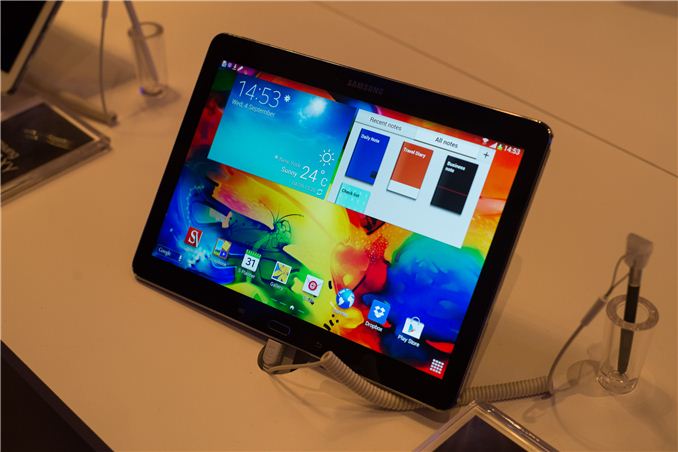Samsung Introduces Galaxy Note 10.1 (2014 Edition) with 2560x1600 Display
by Anand Lal Shimpi on September 4, 2013 10:47 PM EST- Posted in
- Tablets
- Samsung
- Mobile
- Galaxy Note
- Galaxy Note 10.1

Alongside the Galaxy Note 3, Samsung also updated its 10.1-inch Galaxy Note with a 2014 Edition of the tablet. The changes to the 10.1-inch Galaxy Note mirror those of the Galaxy Note 3. The industrial design gets an update to include a faux leather back cover with stitching and textured rim. The combination of the two, once again, is a nice deperature from the slippery plastic of previous Galaxy tablets but still lacks the premium feel of metal. Unlike the Note 3, the 2014 Galaxy Note 10.1 is only available in jet black or classic white.
Internally we see many of the same changes that impacted the Galaxy Note 3. LTE versions of the tablet will feature a 2.3GHz Qualcomm Snapdragon 800 SoC, while 3G and WiFi versions of the tablet will ship with Samsung's own Exynos 5420.
The display moves to a 2560 x 1600 "Super Clear" LCD. Storage options range from 16GB to 64GB, and all variants come with a microSD card slot.
The 2014 Galaxy Note 10.1 will ship in Q3 with Android 4.3 and Samsung's KNOX.
















31 Comments
View All Comments
CZroe - Monday, September 9, 2013 - link
They have patents on radio-neutral ceramic or something but I would think that an RF window would be too obvious to patent.hikka - Thursday, September 5, 2013 - link
what? do you mean you don't enjoy premium feeling aluminium cans when every time when you drink colaTheDistantSea - Thursday, September 5, 2013 - link
Please read your comment again and try to find anything in it that has to do with the FEEL of the material.ESC2000 - Friday, September 6, 2013 - link
I have to agree. I'm tired of the little pissy jabs at any company that is not Apple on this site as well as others. I was really excited to go online and read about Samsung's new products, but the Engadget reporting was filled with pissy comments about plastic v metal, how every touchwiz feature is a gimmick, how Samsung is plagued with "build quality problems" (by that they don't mean the products are more likely to break or deteriorate - instead they mean it is not made out of metal), etc. Don't get me wrong: I agree to some extent with the criticisms. I don't like the type of plastic Samsung uses, and I definitely don't like faux leather and stitching. Some of the new software features are gimmicky.But the articles don't make these points in a reasonable way that recognizes that things aren't black and white. They make then in a pissy way and they perseverate on them as if we've never heard the criticism that Samsung should use metal instead of plastic.
I know I'm being rant-y. I swear I'm not an anti apple fanatic. I can recognize its pros. I just get tired of reading articles that focus on non-apple products' cons but rarely do the same for apple products. Observing this turns me into a fanboy for all noon apple companies and OSes.
Krysto - Thursday, September 5, 2013 - link
Because if you use it for drawing, AMOLED is probably going to suck for your colors. Also, AMOLED is more expensive, and they're already adding to the price by including the S-pen and the digitizer.JlHADJOE - Thursday, September 5, 2013 - link
Pretty sure AMOLED can be calibrated just like any other display tech. More often than not, it's the lack of calibration that causes bad colors, not the type of the display.nerd1 - Thursday, September 5, 2013 - link
A bunch of professional displays are now made in OLED.plewis00 - Thursday, September 5, 2013 - link
AMOLED colours shift over time which is why older AMOLED displays have more of a blue tinge (usually) - it's due to the way the coloured subpixels age. Then you have sunlight legibility and burn-in issues. For a panel of this size you're better off with a good LCD like here, I'm sure if it were viable Samsung would have considered or been using it for this product.Anyway, it's not like a good LCD is hard to come by, look at HTC's and Apple's products.
Solandri - Thursday, September 5, 2013 - link
Yeah, AMOLED is actually better for color work because it has a wider gamut than anything by 3-LED (RGB) LCDs. Its problem on phones and tablets is calibration - Google won't add color calibration to Android even though the graphics hardware supports LUTs.The other color problem with AMOLED is that the screen's color shifts more over time than LCD, and they (can) degrade unevenly. The different color OLED subpixels degrade faster than LED backlights, and they degrade at different rates depending on use.
Krysto - Monday, September 9, 2013 - link
AMOLED is more expensive at the same resolution.I'm more upset they haven't announced the 12.2" version. Also, if Note 3 has 32GB as the minimum storage, why not the Note 10.1, too? Come on, Samsung! That's not cool at all.